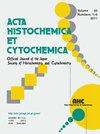KCC2在正常和1型糖尿病模型小鼠胰岛α细胞中的特异性表达
IF 1.8
4区 生物学
Q4 CELL BIOLOGY
引用次数: 3
摘要
γ-氨基丁酸(GABA)是成熟大脑中的一种抑制性神经递质;然而,它在发育过程中起兴奋作用。这种作用差异取决于细胞内氯离子浓度,主要由氯化钾共转运蛋白2(KCC2)调节。充分的KCC2表达导致其抑制作用。GABA在胰岛中也很丰富,它对胰岛细胞有不同的作用,并参与碳水化合物代谢。然而,差异作用的机制仍然未知。我们对正常成年胰岛中的谷氨酸脱羧酶(GAD)、GABA的合成酶和KCC2进行了免疫组织化学检测。GAD与胰岛素在β细胞中共定位,而KCC2在胰高血糖素阳性的α细胞中表达。这些结果与先前的观察结果一致,即GABA降低胰高血糖素的释放,但增加胰岛素的释放,并表明GABA和胰岛素可能在高血糖下共同降低血糖水平。接下来,我们检测链脲佐菌素诱导的1型糖尿病小鼠模型。GAD和胰岛素表达水平显著降低。KCC2在胰高血糖素阳性细胞中表达,而胰岛素和生长抑素阳性细胞为KCC2阴性。这些发现表明,在糖尿病模型中,GABA释放减少可能会导致胰高血糖素释放的抑制作用减弱,导致血糖水平升高并维持高血糖状态。本文章由计算机程序翻译,如有差异,请以英文原文为准。
Specific Expression of KCC2 in the α Cells of Normal and Type 1 Diabetes Model Mouse Pancreatic Islets
Gamma-aminobutyric acid (GABA) is an inhibitory neurotransmitter in the mature brain; however, it acts excitatory during development. This difference in action depends on the intracellular chloride ion concentration, primarily regulated by potassium chloride co-transporter2 (KCC2). Sufficient KCC2 expression results in its inhibitory action. GABA is also abundant in pancreatic islets, where it acts differentially on the islet cells, and is involved in carbohydrate metabolism. However, the mechanisms underlying the differential action remain unknown. We performed immunohistochemistry for glutamic acid decarboxylase (GAD), a synthetic enzyme for GABA, and KCC2 in normal adult islets. GAD was co-localized with insulin in β cells, whereas KCC2 was expressed in glucagon-positive α cells. These results are in line with previous observations that GABA decreases glucagon release but increases insulin release, and suggest that GABA and insulin may work together in reducing blood glucose levels under hyperglycemia. Next, we examined the streptozotocin-induced type1 diabetes mellitus mouse model. GAD and insulin expression levels were markedly decreased. KCC2 was expressed in glucagon-positive cells, whereas insulin- and somatostatin-positive cells were KCC2-negative. These findings suggest that in diabetes model, reduced GABA release may cause disinhibition of glucagon release, resulting in increased blood sugar levels and the maintenance of hyperglycemic state.
求助全文
通过发布文献求助,成功后即可免费获取论文全文。
去求助
来源期刊

Acta Histochemica Et Cytochemica
生物-细胞生物学
CiteScore
3.50
自引率
8.30%
发文量
17
审稿时长
>12 weeks
期刊介绍:
Acta Histochemica et Cytochemica is the official online journal of the Japan Society of Histochemistry and Cytochemistry. It is intended primarily for rapid publication of concise, original articles in the fields of histochemistry and cytochemistry. Manuscripts oriented towards methodological subjects that contain significant technical advances in these fields are also welcome. Manuscripts in English are accepted from investigators in any country, whether or not they are members of the Japan Society of Histochemistry and Cytochemistry. Manuscripts should be original work that has not been previously published and is not being considered for publication elsewhere, with the exception of abstracts. Manuscripts with essentially the same content as a paper that has been published or accepted, or is under consideration for publication, will not be considered. All submitted papers will be peer-reviewed by at least two referees selected by an appropriate Associate Editor. Acceptance is based on scientific significance, originality, and clarity. When required, a revised manuscript should be submitted within 3 months, otherwise it will be considered to be a new submission. The Editor-in-Chief will make all final decisions regarding acceptance.
 求助内容:
求助内容: 应助结果提醒方式:
应助结果提醒方式:


